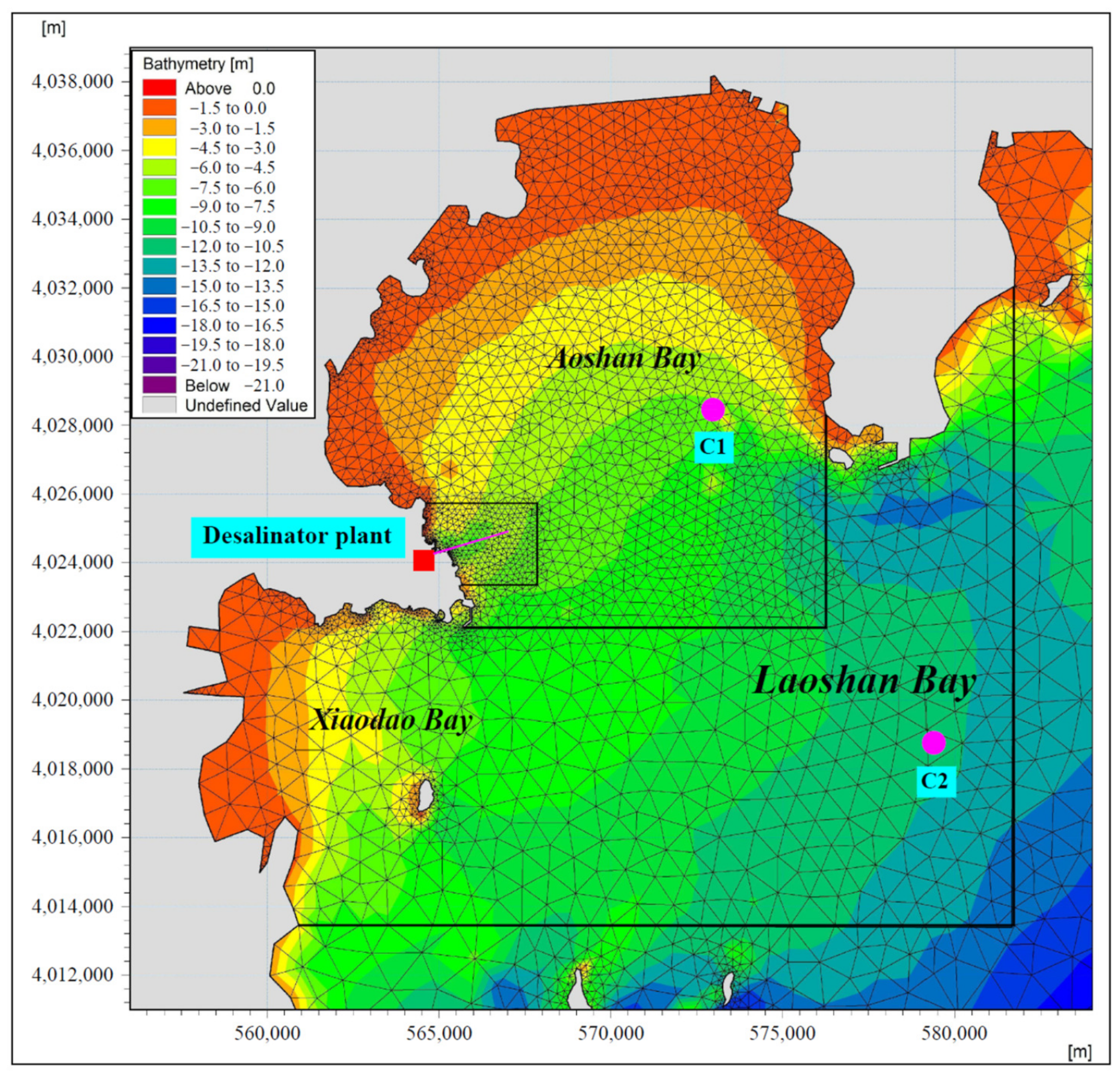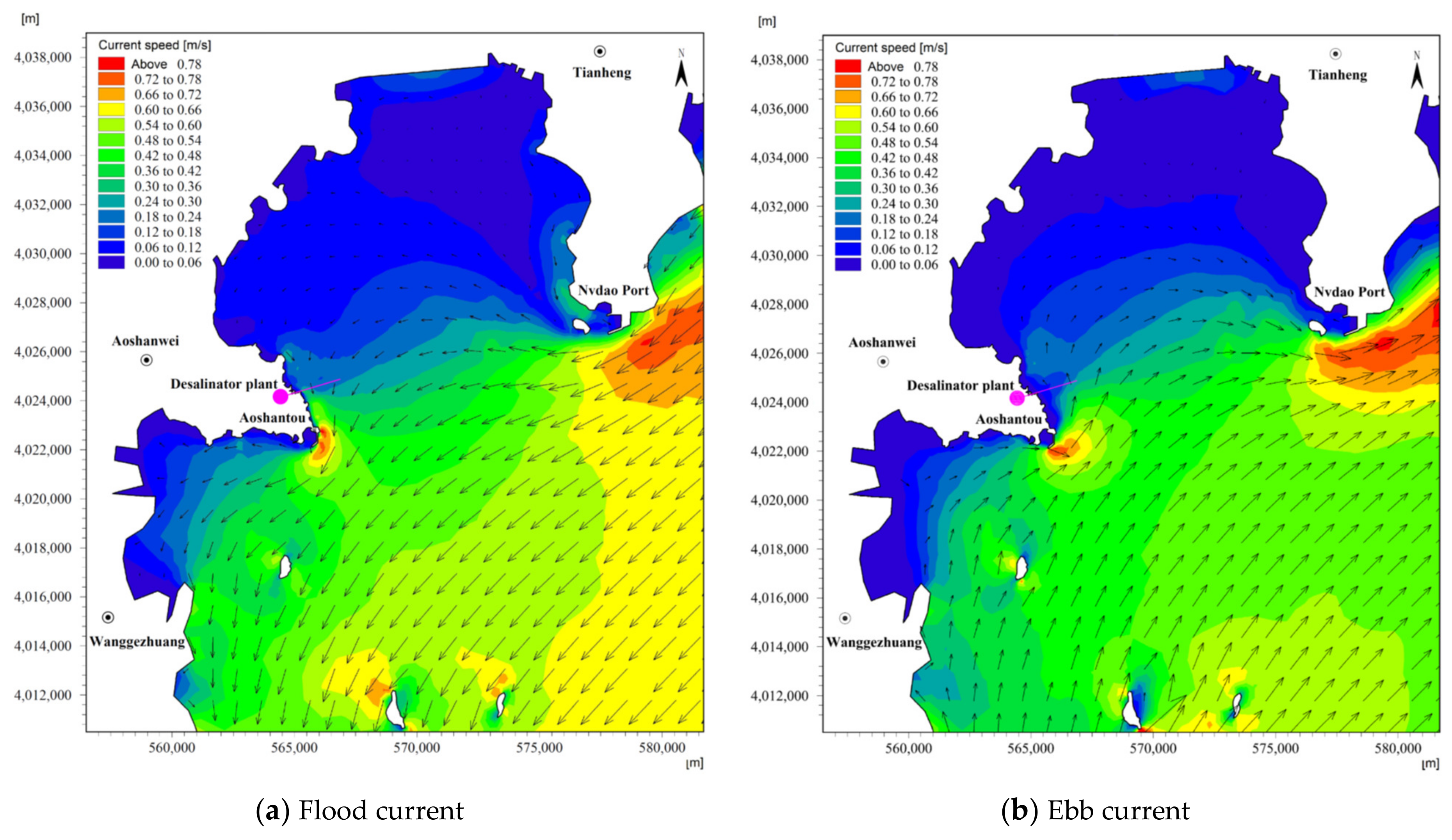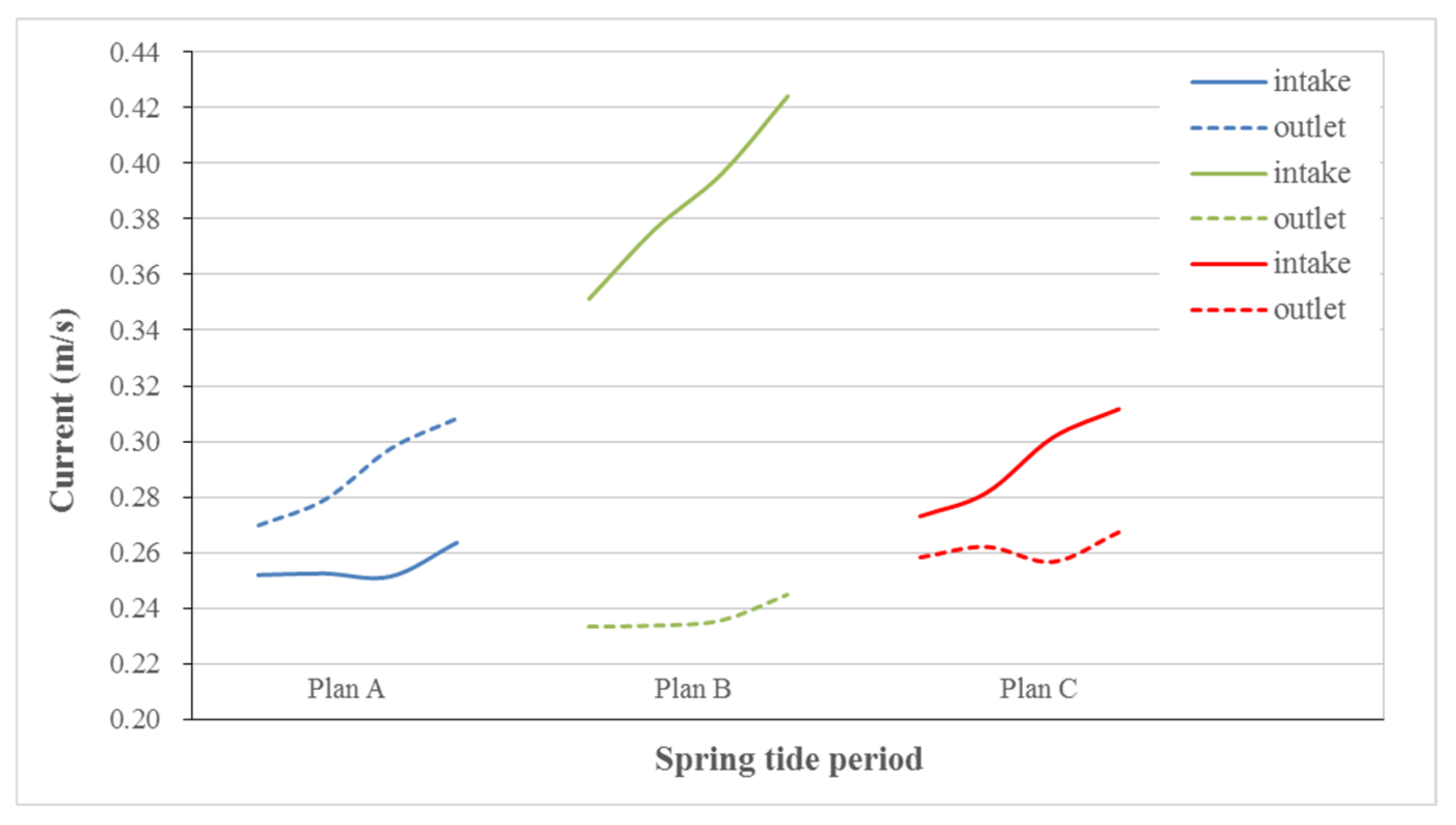Numerical Simulation for Optimization of the Water Intake-Outlet Arrangements for Seawater Desalination Plants Based on MIKE21: A Case Study of Laoshan Bay, Qingdao
Abstract
:1. Introduction
2. Study Area and Desalination Engineering
2.1. Study Area
2.2. Desalination Engineering
3. Numerical Model
3.1. MIKE21 Model
3.2. Model Building
3.2.1. Mesh Grid
3.2.2. Conditions and Parameters
3.2.3. Model Verification
4. Results and Discussion
4.1. Simulation Results of Tidal Flow Field in Laoshan Bay
4.2. Simulation Results of Salinity Field after Brine Discharge
4.3. Comparison and Optimization of Water Intake-Outlet Layout Schemes
5. Conclusions
Author Contributions
Funding
Data Availability Statement
Conflicts of Interest
References
- Zhang, F.K.; Zou, C.L.; Li, L.; Liu, S.J. Policies of seawater intaking in USA and their reference for seawater desalination in China. J. Econ. Water Resour. 2016, 34, 53–55. [Google Scholar]
- Zhang, D.M.; Shi, X.D.; Wang, D.; Kou, Y.D. Study of seawater intake and drainage methods selection and design features for seawater desalination plant. Mod. Ind. Econ. Inf. 2017, 24, 31–33. [Google Scholar]
- Zhu, Q.; Zuo, L.M.; Shan, K.; Ma, W. The suitability of desalinated water intake in coastal areas of Beijing, Tianjin & Hebei. Ocean Dev. Manag. 2017, 2, 80–84. [Google Scholar]
- Huang, Y.J.; Chen, Q.Z.; Zeng, J.N.; Jiang, Z.B. Influences of the high salinity wastewater from desalination plants on the marine ecological environment. J. Mar. Sci. 2009, 27, 103–110. [Google Scholar]
- Portillo, E.; De La Rosa, M.R.; Louzara, G.; Ruiz, J.M.; Marín-Guirao, L.; Quesada, J.; González, J.C.; Roque, F.; González, N.; Mendoza, H. Assessment of the abiotic and biotic effects of sodium metabisulphite pulses discharged from desalination plant chemical treatments on seagrass (Cymodocea nodosa) habitats in the Canary Islands. Mar. Pollut. Bull. 2014, 80, 222–233. [Google Scholar] [CrossRef]
- Panagopoulos, A.; Haralambous, K.-J. Environmental impacts of desalination and brine treatment-Challenges and mitigation measures. Mar. Pollut. Bull. 2020, 161, 111773. [Google Scholar] [CrossRef]
- Pérez Talavera, J.; Quesada Ruiz, J. Identification of the mixing processes in brine discharges carried out in Barranco del Toro Beach, south of Gran Canaria (Canary Islands). Desalination 2001, 139, 277–286. [Google Scholar] [CrossRef]
- Malfeito, J.J.; Díaz-Caneja, J.; Fariñas, M.; Fernández-Torrequemada, Y.; González-Correa, J.M.; Carratalá-Giménez, A.; Sánchez-Lizaso, J.L. Brine discharge from the Javea desalination plant. Desalination 2005, 185, 87–94. [Google Scholar] [CrossRef]
- McAllen, R.; Taylor, A. The effect of salinity change on the oxygen consumption and swimming activity of the high-shore rockpool copepod Tigriopus brevicornis. J. Exp. Mar. Biol. Ecol. 2001, 263, 227–240. [Google Scholar] [CrossRef]
- Belkin, N.; Rahav, E.; Elifantz, H.; Kress, N.; Berman-Frank, I. The effect of coagulants and antiscalants discharged with seawater desalination brines on coastal microbial communities: A laboratory and in situ study from the southeastern Mediterranean. Water Res. 2017, 110, 321–331. [Google Scholar] [CrossRef]
- Frank, H.; Fussmann, K.-E.; Rahav, E.; Bar-Zeev, E. Chronic effects of brine discharge form large-scale seawater reverse osmosis desalination facilities on benthic bacteria. Water Res. 2019, 151, 478–487. [Google Scholar] [CrossRef]
- Bianchelli, S.; Martire, M.L.; Pola, L.; Gambi, C.; Fanelli, E.; Danovaro, R.; Corinaldesi, C. Impact of hypersaline brines on benthic meio- and macrofaunal assemblages: A comparison from two desalination plants of the Mediterranean Sea. Desalination 2022, 532, 115756. [Google Scholar] [CrossRef]
- Malcangio, D.; Petrillo, A.F. Modeling of brine outfall at the planning stage of desalination plants. Desalination 2010, 254, 114–125. [Google Scholar] [CrossRef]
- Papakonstantis, I.G.; Christodoulou, G.C.; Papanicolaou, P.N. Inclined negatively buoyant jets 1: Geometrical characteristics. J. Hydraul. Res. 2011, 49, 3–12. [Google Scholar] [CrossRef]
- Papakonstantis, I.G.; Christodoulou, G.C.; Papanicolaou, P.N. Inclined negatively buoyant jets 2: Concentration measurements. J. Hydraul. Res. 2011, 49, 13–22. [Google Scholar] [CrossRef]
- Cui, Z.F.; Hu, D.C. Numerical simulation study of erosion-deposition laws of riverbed around submerged water intake. Yangtze River 2015, 46, 31–45. [Google Scholar]
- Abdullaev, K.M.; Agamaliev, M.M.; Akhmedova, D.A. Technology for combined desalination of seawater. J. Water Chem. Technol. 2019, 41, 119–124. [Google Scholar] [CrossRef]
- Zhu, C.J.; Liang, Z.Q.; Yan, F.; Hao, W.L. Reduction of waste water in Erhai Lake based on MIKE21 hydrodynamic and water quality model. Sci. World J. 2013, 2013, 958506. [Google Scholar] [CrossRef] [Green Version]
- Dubinina, E.O.; Miroshnikov, A.Y.; Kossova, S.A.; Flint, M.V. Numerical estimations of desalinated seawater modification using waters of the Laptev Sea shelf as an example. Dokl. Earth Sci. 2019, 484, 109–113. [Google Scholar] [CrossRef]
- Li, X.J.; Huang, M.T.; Wang, R.H. Study of Donghu Lake water eutrophication simulation based on MIKE. IOP Conf. Ser. Earth Environ. Sci. 2019, 435, 012013. [Google Scholar]
- Wang, K.; Du, J.; Liu, M.; Wu, J.H.; Jiang, H.Z.; Jin, S.; Song, L. Numerical simulation of Bohai oil Spill in the winter sea ice period. China Ocean Eng. 2019, 33, 185–197. [Google Scholar] [CrossRef]
- Li, W.D.; Li, M.G.; Pang, Q.X.; Wang, C.Y. Study on mathematical model for water intake and drainage project of Taishan Nuclear Power Station. J. Waterw. Harb. 2011, 32, 94–100. [Google Scholar]
- Zhao, J.; Chen, J.F. Research on hydro-environment of Aoshan Bay. Mar. Fish. Res. 2001, 22, 59–63. [Google Scholar]
- Sun, W.; Tang, X.C.; Xu, Y.D.; Liu, Y.J.; Ma, J.X.; Zhang, H.J. Characteristics of nutrients and eutrophication assessment of the Laoshan Bay, Qingdao. Trans. Oceanol. Limnol. 2016, 6, 45–52. [Google Scholar]
- Wu, Y.J.; Mei, N.; Liang, B.C. Study on transport and diffusion of concentrated and heated brine under the action of tide in Jiaozhou Bay. Period. Ocean Univ. China 2008, 38, 1029–1034. [Google Scholar]
- Wood, J.E.; Silverman, J.; Galanti, B.; Biton, E. Modelling the distributions of desalination brines from multiple sources along the Mediterranean coast of Israel. Water Res. 2020, 173, 115555. [Google Scholar] [CrossRef]
- Liu, W.X.; Luan, Z.K.; Tang, H.X. Environmental assessment on heavy metal pollution in the sediments of Le’an river with potential ecological risk index. Acta Ecol. Sin. 1999, 19, 206–211. [Google Scholar]
- Pistocchi, A.; Bleninger, T.; Dorati, C. Screening the hurdles to sea disposal of desalination brine around the Mediterranean. Desalination 2020, 491, 114570. [Google Scholar] [CrossRef]











| Parameter | Value |
|---|---|
| Minimum time step interval | 0.4 s |
| CFL number | 0.8 |
| Flooding depth | 0.15 m |
| Horizontal eddy viscosity coefficient | 0.2 |
| Manning coefficient | 40~94 m1/3/s |
| Brine discharge | 8.7 m3/d |
| Initial salinity | 31.8 PSU |
| Source salinity | 53.5 PSU |
| Transverse diffusion coefficient | 0.1 m2/s |
| Layouts | Area of the Salinity Increment (km2) | Diffusion Distance of 0.5 PSU Salinity Increment (m) | The Maximum Salinity (PSU) | ||||
|---|---|---|---|---|---|---|---|
| 0.5 PSU | 1 PSU | 1.5 PSU | Transverse to Current Direction | Parallel to Current Direction | Intake | Outlet | |
| Plan A | 0.332 | 0.050 | 0.012 | 421 | 1212 | 32.1 | 33.6 |
| Plan B | 0.508 | 0.052 | 0.016 | 522 | 1472 | 32.0 | 33.8 |
| Plan C | 0.798 | 0.092 | 0.026 | 492 | 2066 | 31.9 | 34.1 |
Disclaimer/Publisher’s Note: The statements, opinions and data contained in all publications are solely those of the individual author(s) and contributor(s) and not of MDPI and/or the editor(s). MDPI and/or the editor(s) disclaim responsibility for any injury to people or property resulting from any ideas, methods, instructions or products referred to in the content. |
© 2023 by the authors. Licensee MDPI, Basel, Switzerland. This article is an open access article distributed under the terms and conditions of the Creative Commons Attribution (CC BY) license (https://creativecommons.org/licenses/by/4.0/).
Share and Cite
Jin, Y.; Du, J.; Gu, D.; Yan, W.; Sun, Y.; Wang, Y. Numerical Simulation for Optimization of the Water Intake-Outlet Arrangements for Seawater Desalination Plants Based on MIKE21: A Case Study of Laoshan Bay, Qingdao. Water 2023, 15, 2402. https://doi.org/10.3390/w15132402
Jin Y, Du J, Gu D, Yan W, Sun Y, Wang Y. Numerical Simulation for Optimization of the Water Intake-Outlet Arrangements for Seawater Desalination Plants Based on MIKE21: A Case Study of Laoshan Bay, Qingdao. Water. 2023; 15(13):2402. https://doi.org/10.3390/w15132402
Chicago/Turabian StyleJin, Yuxiu, Jun Du, Dongqi Gu, Wenwen Yan, Yonggen Sun, and Yongzhi Wang. 2023. "Numerical Simulation for Optimization of the Water Intake-Outlet Arrangements for Seawater Desalination Plants Based on MIKE21: A Case Study of Laoshan Bay, Qingdao" Water 15, no. 13: 2402. https://doi.org/10.3390/w15132402




